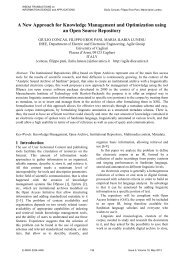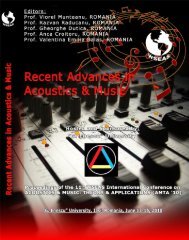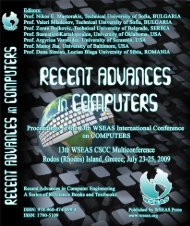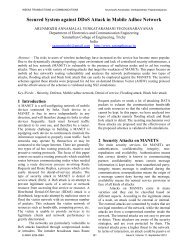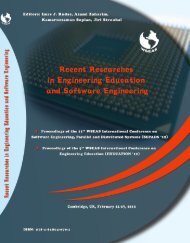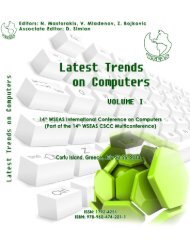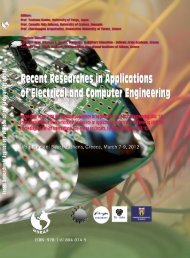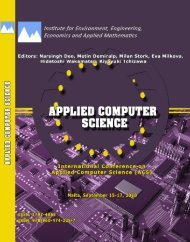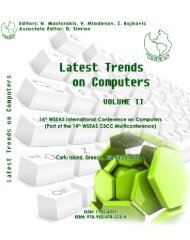Contents - Wseas.us
Contents - Wseas.us
Contents - Wseas.us
Create successful ePaper yourself
Turn your PDF publications into a flip-book with our unique Google optimized e-Paper software.
Proceedings of the 9th WSEAS International Conference on SIMULATION, MODELLING AND OPTIMIZATION<br />
Keynote Lecture<br />
Optimization Based Matrix Decomposition Methods and their Utilization in Applications<br />
Professor Metin Demiralp<br />
Informatics Institute<br />
Istanbul Technical University<br />
ITU Bilisim Enstit<strong>us</strong>u Ayazaga Yerleskesi<br />
Maslak, 34469, Istanbul, Turkey<br />
E-mail: metin.demiralp@gmail.com<br />
Abstract: Matrix decomposition methods play important roles in the theoretical aspects of the matrix theory beside<br />
their utilization in approximations. The main purpose is to represent a matrix in terms of the rather simple matrices.<br />
The linear combination type representations are mostly preferred to get the benefits of the linearity. The simple<br />
matrices in the linear combination are chosen in as lower ranks as possible. The one-rank matrices or in other words<br />
outer products are mostly preferred ones. For example, spectral decompositions <strong>us</strong>e outer products constructed as<br />
the product of each normalized eigenvector of the considered matrix by its transpose or hermitian conjugate and the<br />
linear combination coefficients are the corresponding eigenvalues when the symmetry or the hermiticity exists in the<br />
matrix under consideration. If the symmetry or hermiticity does not exist then the cases should be investigated<br />
separately for two different categories first of which involves the matrices with eigenvalues whose algebraic and<br />
geometric multiplicities are same while the second one covers the matrices at least one of whose eigenvalues has<br />
different algebraic and geometric multiplicities. The first group matrices have spectral decompositions almost same<br />
as the symmetric or hermitian matrices with the only difference in the construction of the outer products which are<br />
now constructed as the product of the right eigenvectors by their companion transposed left ones. Although the<br />
individual normalizations of the left and right eigenvectors are not necessary the mutual normalizations are required<br />
to give unit norm to each outer product. The second group matrices can not be expressed in the abovementioned<br />
form of spectral decompositions beca<strong>us</strong>e they can not be diagonalized. Hence, their reducibility to Jordan canonical<br />
form m<strong>us</strong>t be reflected to the decomposition. What we have stated above is for square matrices. The similar<br />
decomposition for the rectangular matrices is based on the idea of the forward and backward transitions between two<br />
different dimensional Euclidean spaces. The result is called singular value decomposition where the outer products<br />
are constructed from the left and right singular vectors while the linear combination coefficients of the decomposition<br />
are the singular values of the matrices which are in fact the square root of the eigenvalues of the product of the<br />
transposed form of the matrix by itself. All these decompositions can be connected to the optimization theory by<br />
defining appropriate cost functionals and constraints. The cost functional has quadratic natures in general. The<br />
constraints may also be quadratic although the bilinear forms are encountered as well. The structure of the cost<br />
functional uniquely defines the characters of decomposition. It is possible to define new and more general<br />
decompositions by changing the structures of the cost functional and the constraints. There have been certain efforts<br />
to do so in recent years. The author and his colleagues are attempting to construct new schemes to decompose<br />
matrices and to <strong>us</strong>e them in modern applications related to data processing. The talk will foc<strong>us</strong> on the issue in a more<br />
general perspective and try to adress to the works by emphasizing on the recent ones from and outside the group of<br />
the author.<br />
Brief Biography of the Speaker: Metin Demiralp was born in Turkey on 4 May 1948. His education from elementary<br />
school to university was entirely in Turkey. He got his BS, MS, and PhD from the same institution, Istanbul Technical<br />
University. He was originally chemical engineer, however, through theoretical chemistry, applied mathematics, and<br />
computational science years he was mostly working on methodology for computational sciences and he is continuing<br />
to do so. He has a group (Group for Science and Methods of Computing) in Informatics Institute of Istanbul Technical<br />
University (he is the founder of this institute). He collaborated with the Prof. Herschel A. Rabitz’s group at Princeton<br />
University (NJ, USA) at summer and winter semester breaks during the period 1985–2003 after his 14 months long<br />
postdoctoral visit to the same group in 1979–1980.<br />
Metin Demiralp has more than 70 papers in well known and prestigio<strong>us</strong> scientific journals, and, more than 110<br />
contributions to the proceedings of vario<strong>us</strong> international conferences. He has given many invited talks in vario<strong>us</strong><br />
ISSN: 1790-2769 15 ISBN: 978-960-474-113-7




